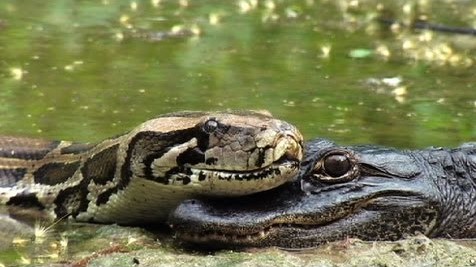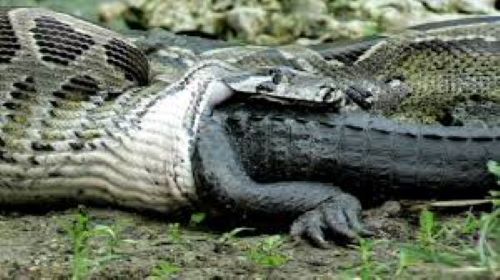Florida’s establishment of the Burmese python has threatened many species in the Florida Everglades. Find out who has become their greatest rival in recent years.
Everglades National Park is home to many Florida species, some which are endangered and some which are not. It is also home to the Burmese python, an invasive species that has been the source of many ecological problems in the Florida Everglades. Many efforts to control the population have been futile. The raging battle that is taking place in South Florida has pinned the Burmese python against the native American alligator. Both species are apex predators and are now competing for the same resources.
The establishment of the Burmese python has coincided with a drastic decline in many mammalian species over the past couple of decades. They started off with smaller mammals, such as rodents and raccoons, and worked their way up to larger animals – which now include the American alligator. Alligators, for the most part, prefer to eat smaller mammals and birds, but due to the decline in the mammalian population, the alligators have been forced to hunt larger animals on a more frequent basis – sometimes including the Burmese python. When these two forces meet in the Everglades, an epic fight is sure to happen.

By now, it has been widely documented that the Burmese python and the American alligator tend to encounter each other in the Florida Everglades. When these two species meet it is almost always a fight to the death. The fight between these distinct but deadly animals is a long and exhaustive one, sometimes extending for several hours. Sometimes the alligator will win and walk around while carrying the dead python in its mouth victoriously. The consequences of a loss in this battle would mean that the alligator will be swallowed whole. In any case, one of these two kings/queens will become dinner for the other.

This epic fight that takes place in Florida grounds can go either way, the advantage is usually granted to the more mature of the two species. A full-grown Burmese python is sure to win and swallow whole a younger, less developed American gator, but the same is true of the reverse.

The American alligators possess one advantage that the Burmese pythons do not have – they hunt in packs. It was believed that alligators were solo hunters, but recently it was discovered that they are actually predators who hunt their prey in coordinated patterns. Dr. Vladimir Dinets, from the University of Tennessee in Knoxville, wrote his discovery in the journal of Ethology Ecology and Evolution. He noted that through hundreds of eyewitness accounts, along with over 3000 hours of his own observations, the common factor that was present in all sightings was that they hunted in a coordinated pattern. The strategies that are implemented depend on the size of the gators. Larger gators might chase a fish from the deep end by splashing their tails in the water and moving the fish to a shallow area where the smaller, more agile gators will be waiting to trap it. Regardless of the pattern, hunting in packs is an almost absolute way to ensure the success of catching the prey, and that every gator will have a chance to eat.

This does not mean that gators are pack animals. For the most part, adults do prefer to spend their time alone, but they still live within proximity to one another and congregate loosely about once a day. In times of a drought, they will remain together and have shown that they will tolerate one another in order to improve their chances of survival.
One gator is trouble enough, but a pack of them will easily feast on a Burmese python if the python is so unfortunate as to be found by the herd.
The Burmese python, on the other hand, has a stealth advantage over the gator. They are known for their mastery in the art of camouflage by scientists and hunters alike. It is probably the reason why there are an estimated 300,000 Burmese pythons in the everglades and only about 200,000 alligators, despite the alligator being the native species. You can’t hunt what you can’t see!











